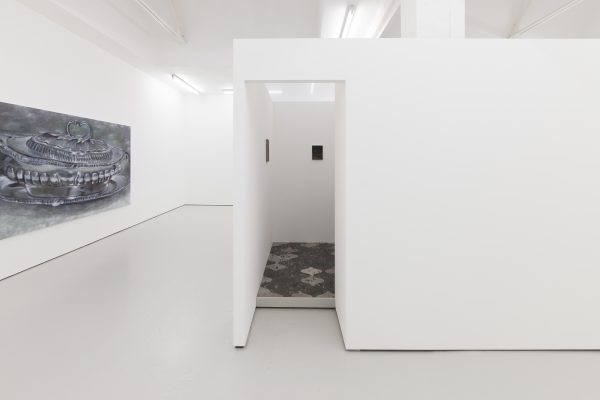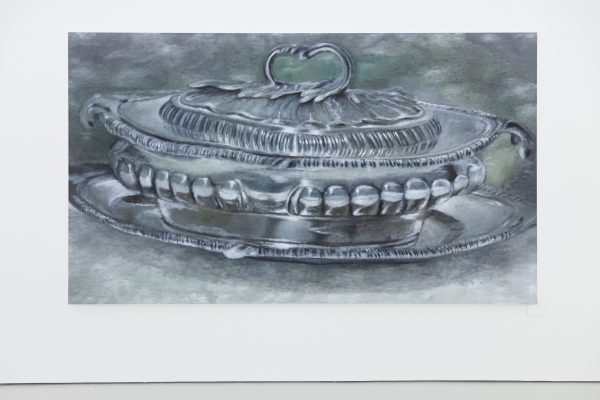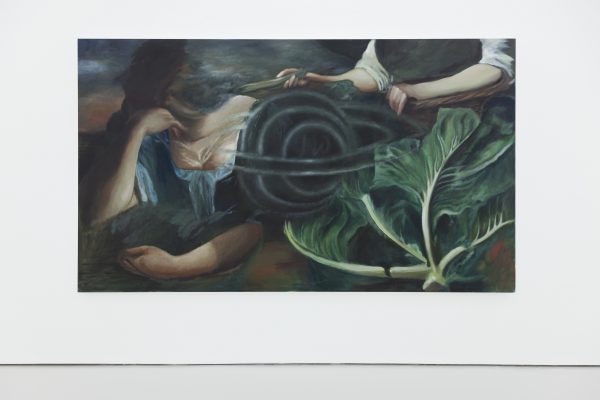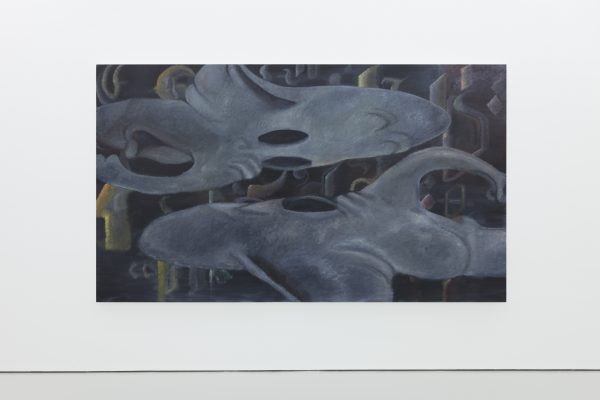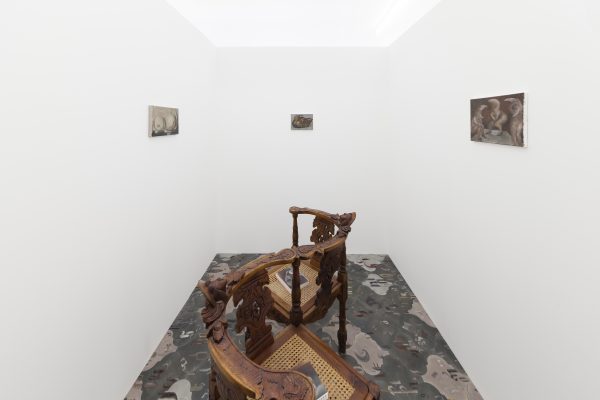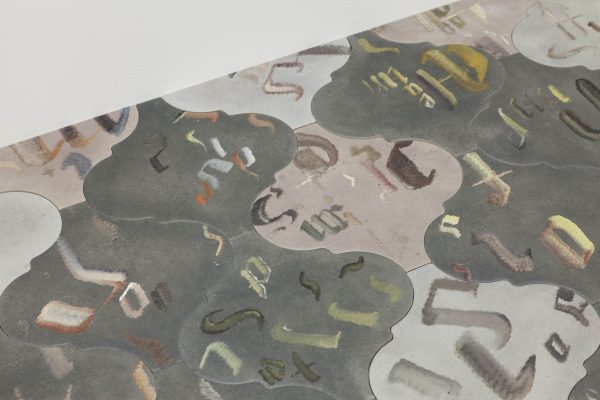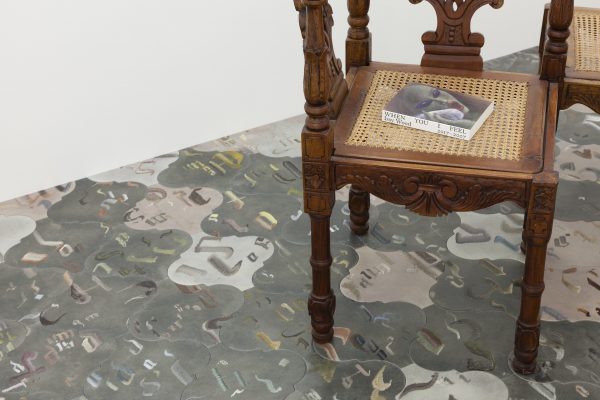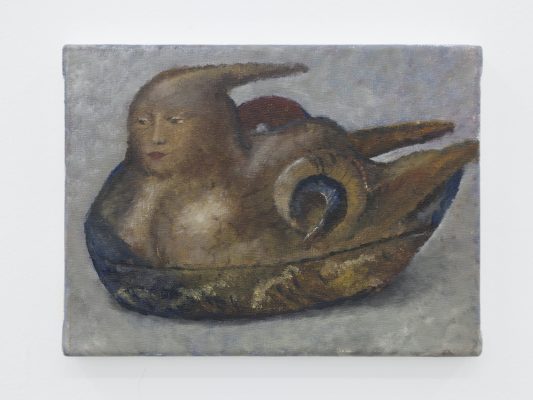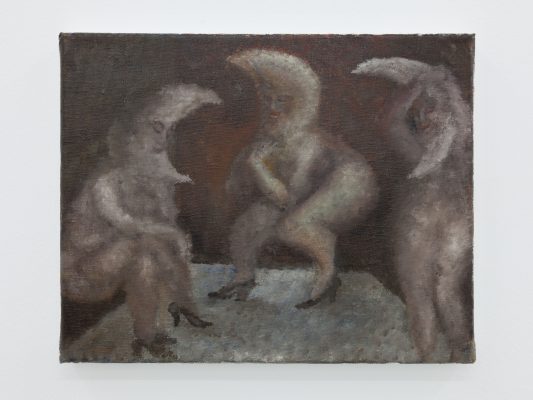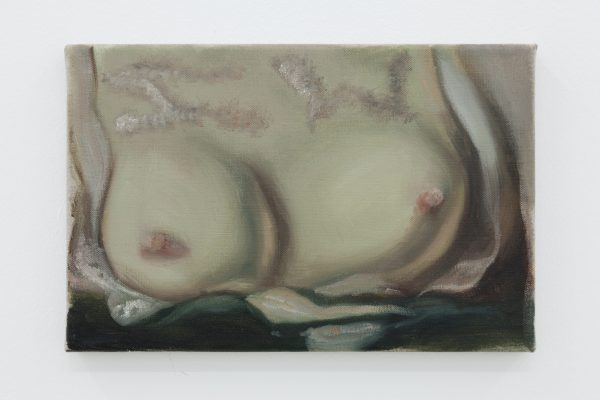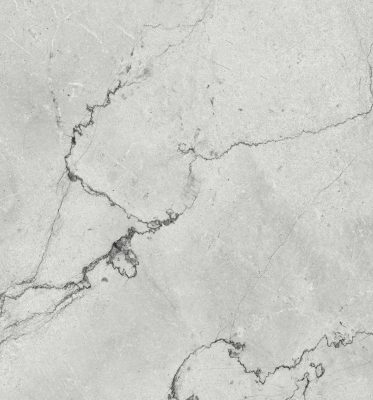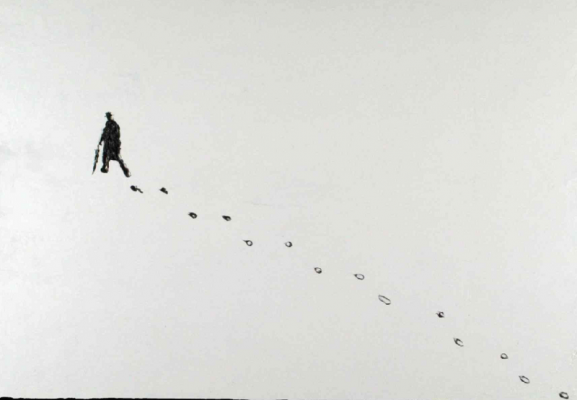At the centre of Issy Wood’s solo exhibition at Carlos/Ishikawa is a room-within-a room. The division of the gallery into two viewing spaces – the inner sanctum and a perimeter corridor – is an intelligent piece of exhibition design for an artist whose work challenges the boundaries separating inside from outside, private from public, self from other, object from image.
The dreamlike, animistic and discomfiting tone of the exhibition is set by the three-metre-wide Study for a Tureen (all works 2017). This woozy impression of ornate silverware is rendered in smudges of cambric white and absinthe green, with an unsteady outline signifying either the compromised physical integrity of the object or the altered psychological state of the viewer. By suggesting that these might be one and the same – that perception cannot be separated from reality – Wood plays on the dual status of painting as object and image, caught on the boundary between the world of things and the world of the imagination. That this item of tableware came to assume a menacingly anthropomorphic aspect – its decorative belt suggesting bared maxillary teeth – showcases Wood’s ability to imbue inanimate objects with something, for want of a better word, like spirit.
The tureen’s sudden strangeness is like the familiar word which, too often repeated, seems to float free of language. This transformation requires intense attention to an isolated detail, so it follows that the most narrative of Wood’s large paintings, The Supervision, is the least convincing. Its implication of an obscure personal symbolism – a man, a woman and a cabbage leaf orbiting a ringed planet – frustrates any attempt to engage with it. More compelling is When You I Feel, a twin head-and-shoulders portrait of two figures with the ears and trunks of elephants. Gazing into each others’ eyes, they seem shocked to recognise in the other a sentient being. Yet the cartoonish elephants – and the problematically ‘othering’ Arabic-effect script on which they are ground – align this painting with the Surrealist tendency to equate the anti-rational unconscious with ‘exotic’ or ‘primitive’ systems of knowledge.
A similar pattern to that which backdrops When You I Feel has been painted onto the ceramic floor tiles that describe an arabesque pattern across the floor of the enclosed inner room. These elusive symbols faintly resemble encoded letters, pictograms or fragments of words in a gothic script but – like the paintings – do not resolve into straightforward legibility. The space is dominated by an antique, double-backed love seat, onto which has been placed a book of the artist’s writing. The publication gathers together a hundred or so micro-fictions, dream scenarios and prose poems which, dated and arranged in reverse chronological order from 2017 to 2007, read like entries in a diary. The clipped rhythms of Wood’s prose and the unperturbed tone in which extraordinary happenings are related – a princess doing a handstand invites a ‘ripped dude’ to paint her toenails – conjure the short stories of Leonora Carrington, while the affectless preoccupation with phone screens and prescription drugs call to mind the frazzled US alt-lit scene.
Like Carrington, and unlike many other artists who feel obliged to try, Wood can really write. While I’m not sure that these fragments could survive separation from the paintings that complement them, they do help to illuminate the artist’s preoccupation with real and imagined experience. Texts like 2013’s ‘multitasker’ or 2015’s ‘Bedtime Story by Madonna’ communicate a desire to escape from the body – or the constraints imposed upon the female body – that resonates with the dissolution of boundaries suggested by When You I Feel, the monism of the sphinx/fashion accessory in Expensive Minaudière 2, and the metamorphoses described by Night Schvitz.
Not knowing that in Yiddish a schvitz means a sauna, I assumed that this trio of women with heads of luminous crescent moons (symbol of madness and feminine mutability) were engaged in some occult ritual. That the painting’s ambiguous interior space resembles the dimensions of the small room in which it hangs puts forward the possibility that this, too, is a site in which women should congregate and transgress. The interpretation survives if the occult is understood to be a term invented by a patriarchal society to criminalise female knowledge and community, even in a sweat room.[1]
Reclaiming the witch as a symbol of female persecution is a popular strategy among artists eager to signal their refusal of patriarchal values (hence the vogue for shows exploring the zodiac, palmistry or paganism). Yet while artists including Juliana Huxtable have used paganism as productive metaphor for the transgression of gender binaries, the uncritical adoption of a ‘witchy aesthetic’ risks creating a lazy visual shorthand for alternative systems of knowledge equivalent to the Surrealists’ use of ‘primitivist’ iconography. Paintings such as Untitled (dog) and Study for a Tureen upset rational, scientistic faiths – on the separation of human and nonhuman, material and immaterial, reason and emotion – without needing to invoke an exotic or archaic culture. This is a more powerfully heretical, transgressive and indeed feminist statement than Night Schvitz’s titillating allusion to the occult can achieve.
IW offers a more direct and provocative commentary on the relationship between art and the female body. In this tightly cropped rendering of a woman’s chest, the artist’s initials appear to have been branded or scarified onto the flesh directly above her exposed breasts. The work relies for its visceral force on the discomforting juxtaposition of burnt or scarred tissue and soft white skin, while also seeming to nod to the art historical convention whereby to paint a woman’s breasts spilling out over her dress signified that she was the commissioner’s mistress. If the history of the female nude in European painting describes the patriarchal control of women’s bodies for the pleasure of a male viewer, then this ‘signature’ might read as a repossession of both the body and the means of representing the body. But the painting – which might equally be said to explore the vulnerability of the young female artist, or the relationship between confessional art and self-harm – resists definitive interpretation. This is to the credit of a promising artist who is at her strongest when seeking out ways to disrupt rather than reinforce conventional logics.
[1] André Breton’s claim that Leonora Carrington was gifted with the ‘illuminism of lucid madness’ – condescension masquerading as praise – is an extension of the misguided principle that female genius should be attributed not to the individual but to their ability unconsciously to channel some sinister power.
